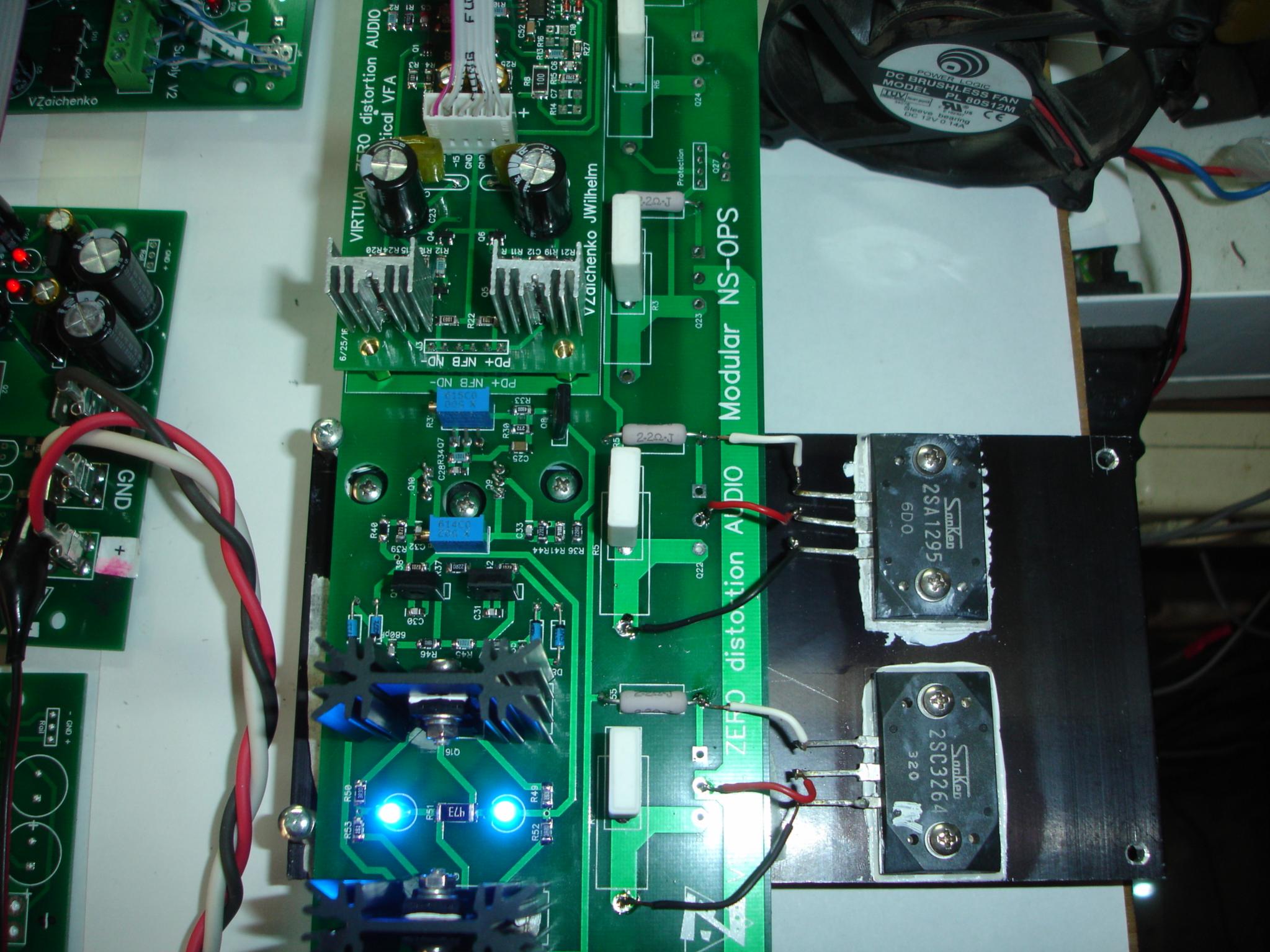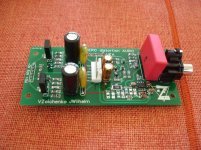Yes,i have to tap the heatsinks!😱Now you've got some work to do!
The template I posted was designed for those heat sinks. I have a milling machine, but I actually prefer to tap those heat sinks with a tap in a cordless drill. Very good quality extrusions. As long as you keep everything cool and clean, tapping is very easy.
Waiting for the heatshink package i had tried an early test.
Nothing special,just i can't resist giving a first listening test.
Excellent sound,deep bass,fine treble very musical....just Excellent!
It is the first time that listening test take place first, before scopes and the measurements!
Huh! Cool )) Never tried it with one pair 🙄
With all tree pairs in place - being capable of providing more current at the output, when required - you will like it even more 😎
Thanks xrk,this is a highly recommended amplifier!
Nice!!! Sweet looking amp.
Congrats on first sound!

You must listen to this.🙂😉
Actually I plan to - it's on my "to build" list. I already have VHEX+ and am very impressed with its performance. This one is supposed to be levels above that one.
Perhaps on a scale with Putzeys' ExtremeA?
Perhaps on a scale with Putzeys' ExtremeA?
Yes i know Valery,this was a very first try under biased(small heatsink) low voltage +/-32v,no protection,one pair out only ,but couldn't wait for a first listening test😉Huh! Cool )) Never tried it with one pair 🙄
With all tree pairs in place - being capable of providing more current at the output, when required - you will like it even more 😎
Last edited:
Hi Valery,
I may have asked this before but I can't find it. Will this NS OPS work with MJL21193/94? I have a pile of those.
Thanks, Terry
I may have asked this before but I can't find it. Will this NS OPS work with MJL21193/94? I have a pile of those.
Thanks, Terry
Hi Valery,
I may have asked this before but I can't find it. Will this NS OPS work with MJL21193/94? I have a pile of those.
Thanks, Terry
Hi Terry,
I will look at it tomorrow. MJL21193/94 have got much lower fT. Need to check a few things, including stability matters.
Cheers,
Valery
I have another question. Most of my stock of SMD resistors are 0805 (1/8W). Are there many of the resistors in the little IPS boards that need to be 1/4W or can I use the 1/8W parts?
Thanks, Terry
Thanks, Terry
If you can check that each resistor's continuous dissipation is below 50% of that 1/8th watt rating, then your 805s are OK, i.e. <60mW. Feedback resistors should probably be kept below 10% of max rating at peaks of output.
Some 805s are higher wattage. I have a few I got from Digikey that are ¼W
Some 805s are higher wattage. I have a few I got from Digikey that are ¼W
I don't have any way to do that at this point. I am populating the boards. I assume that Valery has run sims on all of these little IPS units so it should be relatively simple to check the dissipation. While I 'm in the questioning mode, It looks like the IPS runs on +-15V. Why are the caps rated for 100V?
Thanks, Terry
Thanks, Terry
Power supply for input stage is +/-15v,power supply for drivers and vas is the rail supply after passing a capacitance multiplier.I don't have any way to do that at this point. I am populating the boards. I assume that Valery has run sims on all of these little IPS units so it should be relatively simple to check the dissipation. While I 'm in the questioning mode, It looks like the IPS runs on +-15V. Why are the caps rated for 100V?
Thanks, Terry
Attachments
Last edited:
Hi Terry,i will wait for your listening impressions😉Hi Thimios,
Thanks, I see it now.
Be careful with inp. transistors orientation!
Last edited:
Hi Terry,
I will look at it tomorrow. MJL21193/94 have got much lower fT. Need to check a few things, including stability matters.
Cheers,
Valery
Hi Terry,
I ran a number of simulations - NS-OPS is showing reliable performance with MJL21193/94. Slightly higher level of distortion at 10-20KHz (overall open loop bandwidth is slightly narrower), however - insignificant.
Worth testing.
Cheers,
Valery
I have another question. Most of my stock of SMD resistors are 0805 (1/8W). Are there many of the resistors in the little IPS boards that need to be 1/4W or can I use the 1/8W parts?
Thanks, Terry
Good question. All of 1/4W can be replaced by 1/8 ones, except R9, R13 (8.2K) - those ones have to be 0.25W. BTW, 8.2K is a good value for the rails around +/-52V DC. For the higher rails, the value have to be re-calculated for maintaining the same current through these resistors.
All 1W resistors have to be 1W ones.
Cheers,
Valery
Attachments
Good question. All of 1/4W can be replaced by 1/8 ones, except R9, R13 (8.2K) - those ones have to be 0.25W. BTW, 8.2K is a good value for the rails around +/-52V DC. For the higher rails, the value have to be re-calculated for maintaining the same current through these resistors.
All 1W resistors have to be 1W ones.
Cheers,
Valery
On small IPS boards - all of them are ok to be 1/8W, except the 1W ones, of course.
dissipation is current times voltage.I don't have any way to do that at this point. I am populating the boards. I assume that Valery has run sims on all of these little IPS units so it should be relatively simple to check the dissipation. While I 'm in the questioning mode, It looks like the IPS runs on +-15V. Why are the caps rated for 100V?
Thanks, Terry
You get those from the schematic.
These will be quiescent dissipations and signal only adds a bit to these, except for output emitter resistors and Zobel and such that have very high signal currents..
- Home
- Amplifiers
- Solid State
- Revisiting some "old" ideas from 1970's - IPS, OPS

